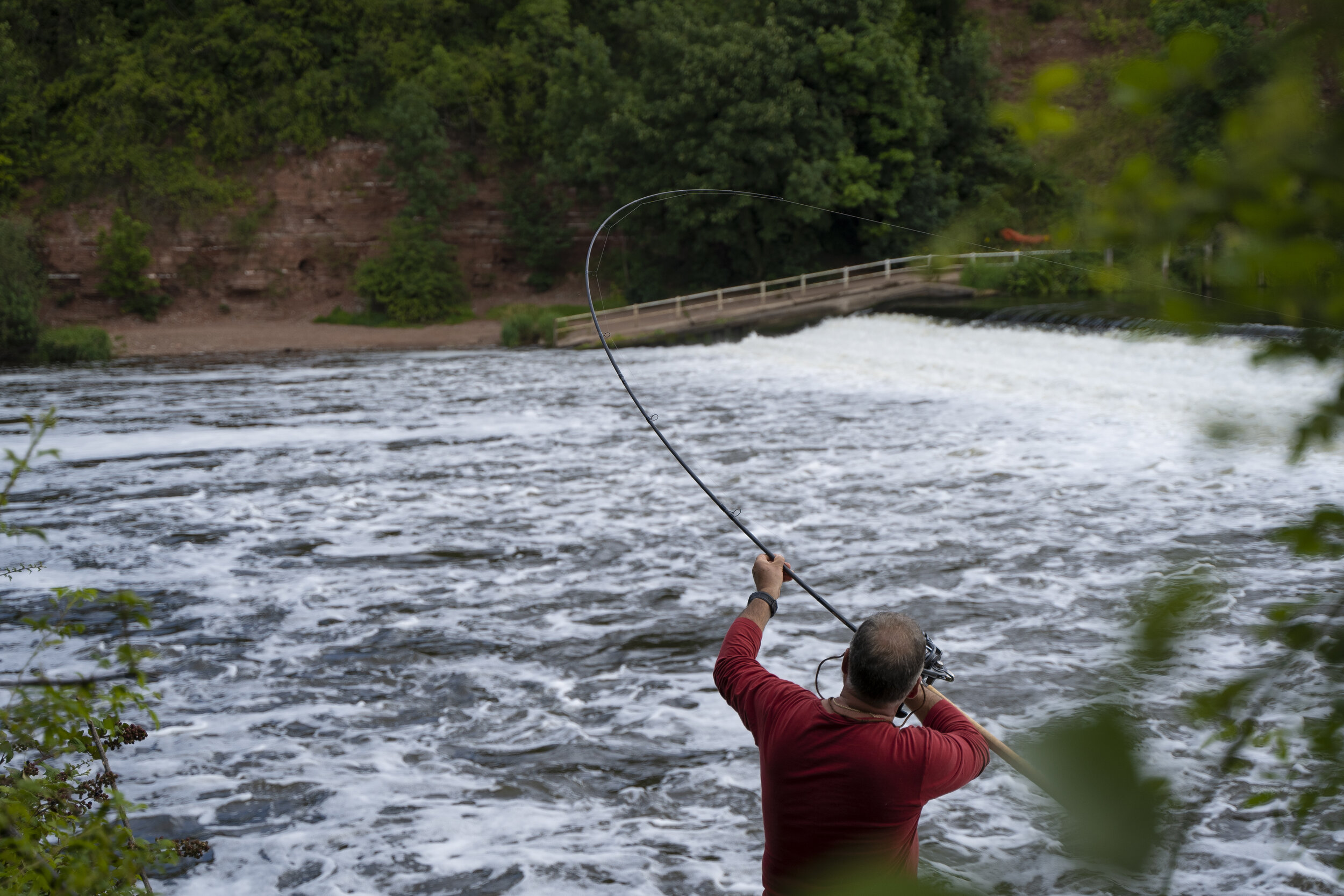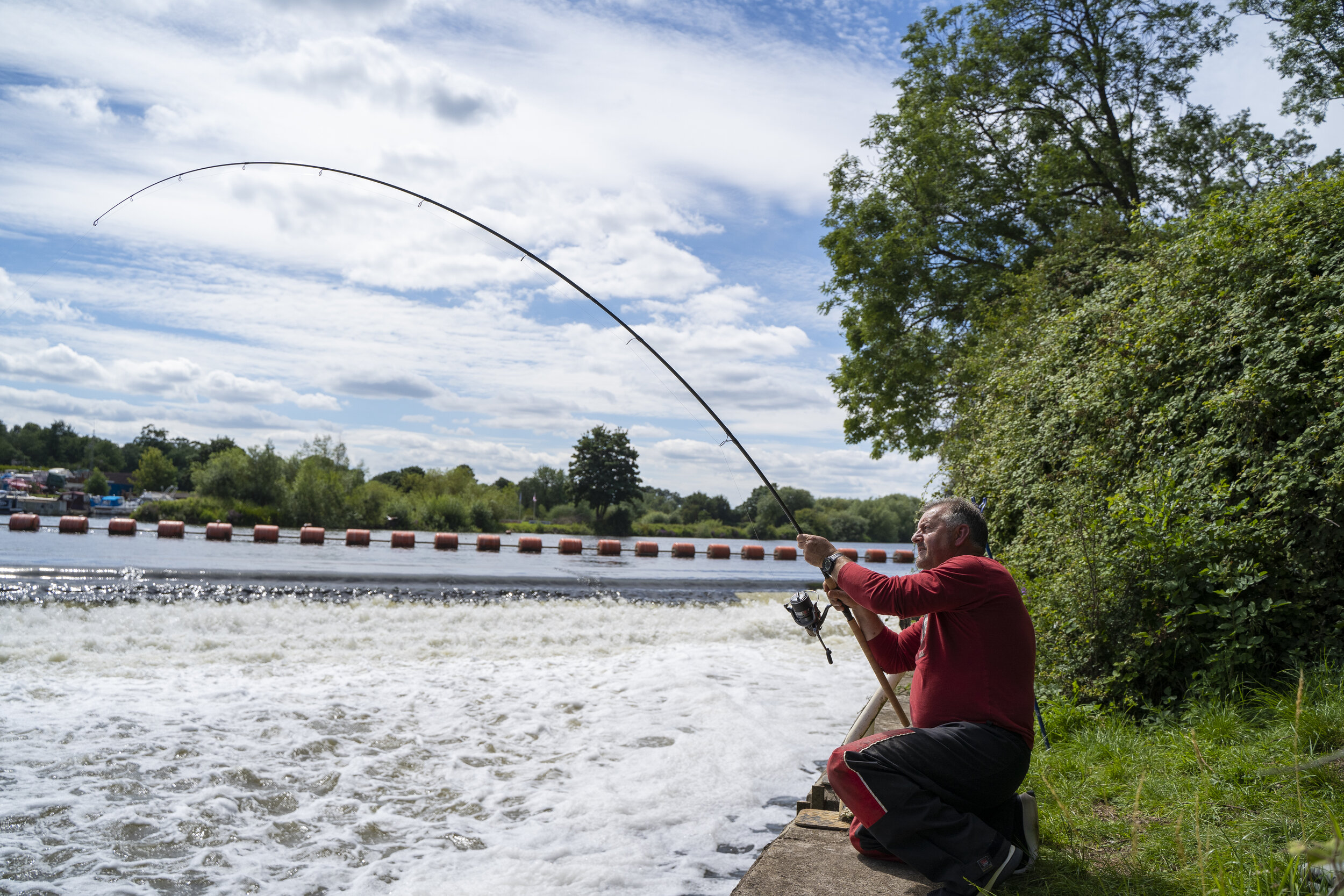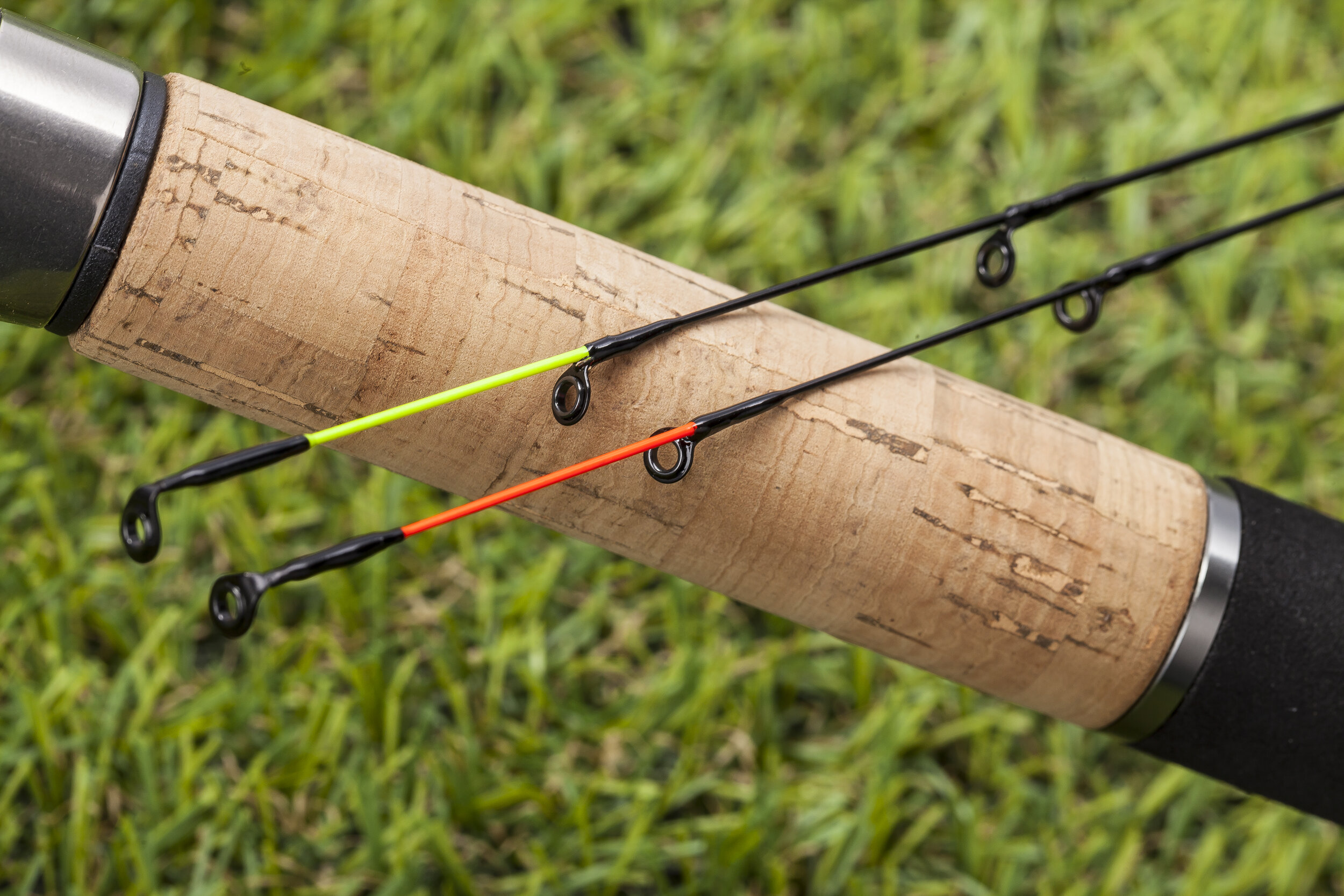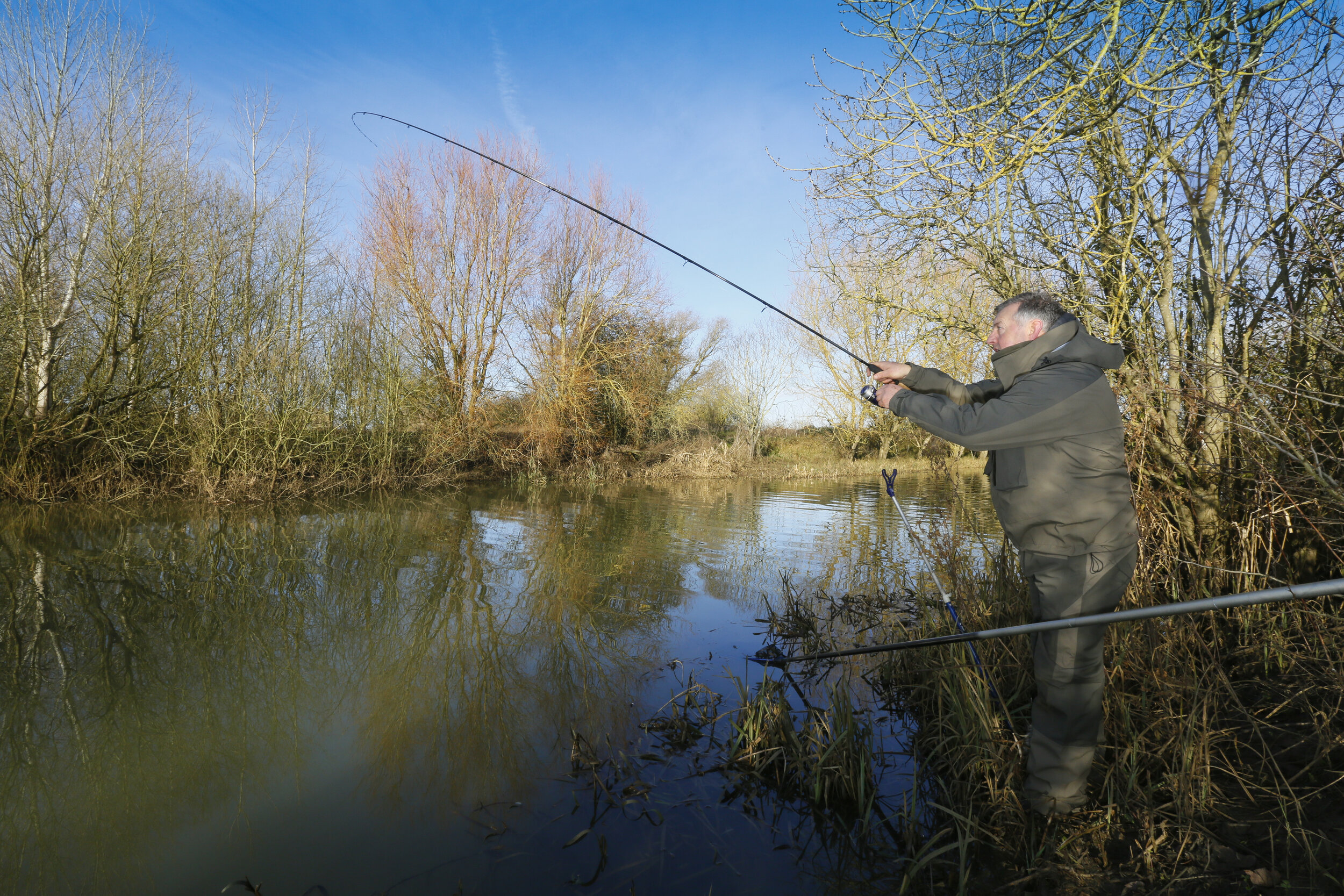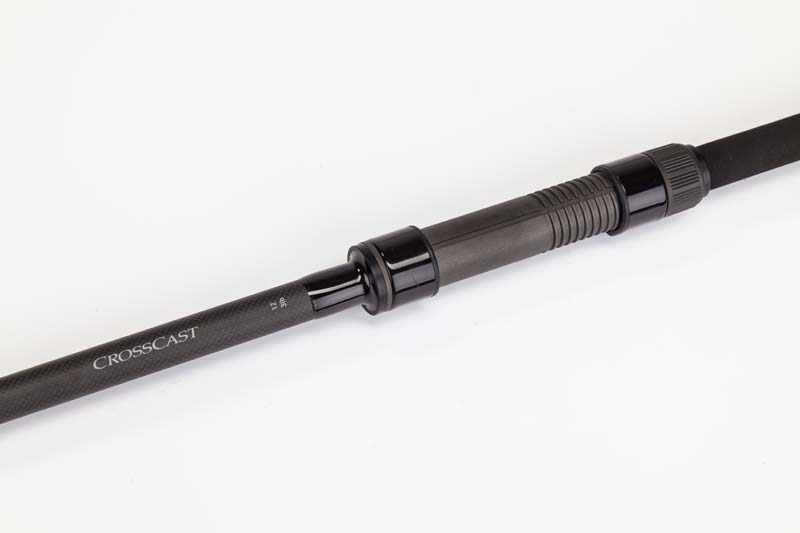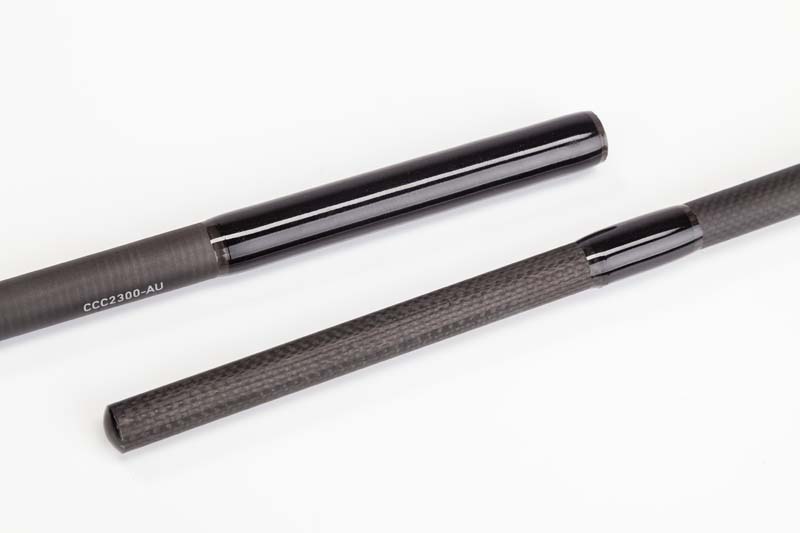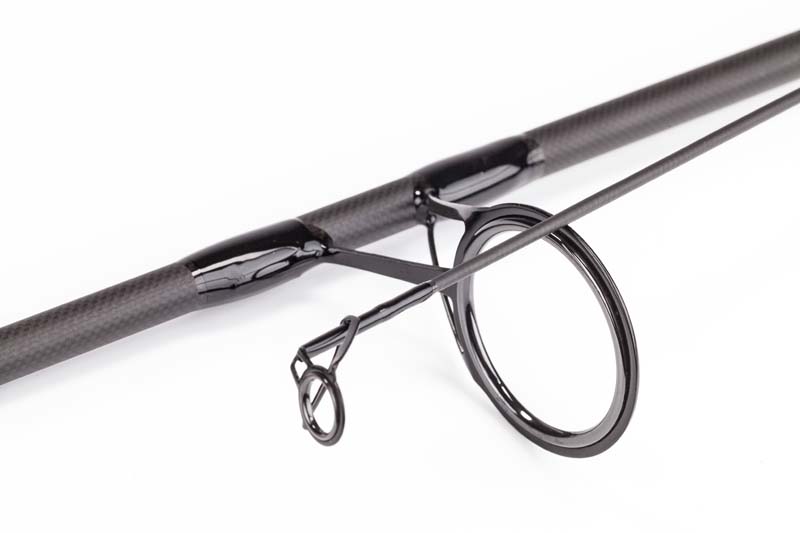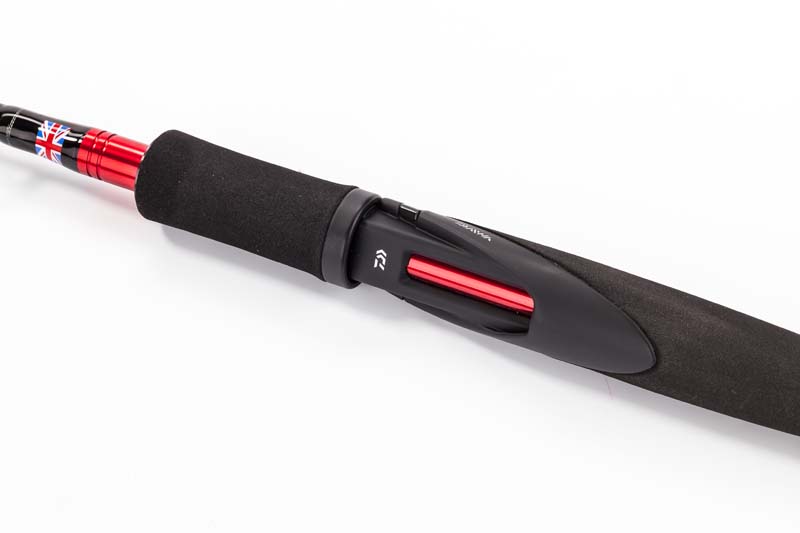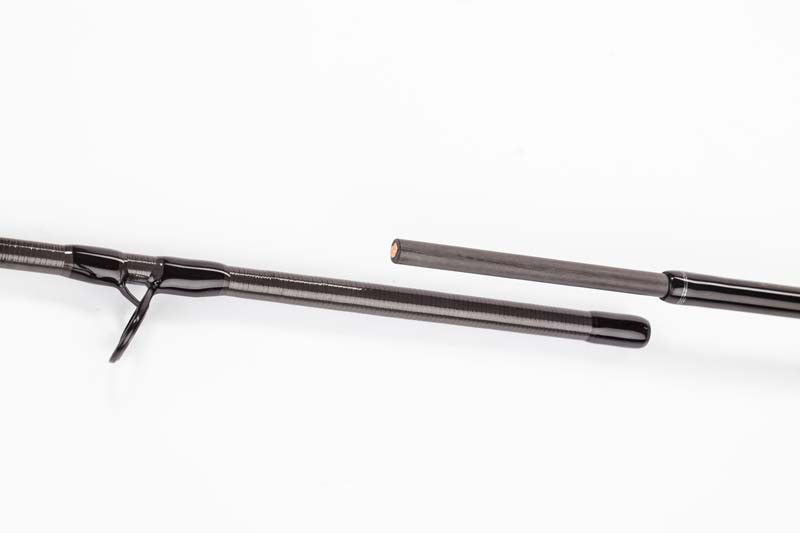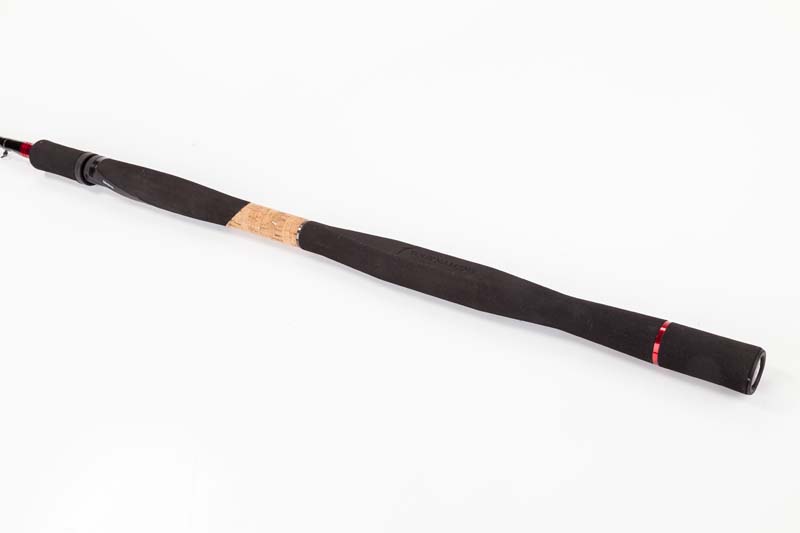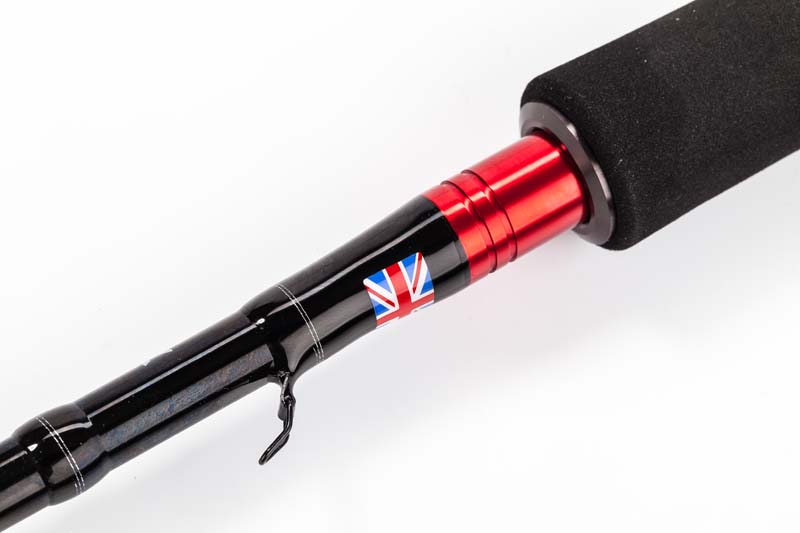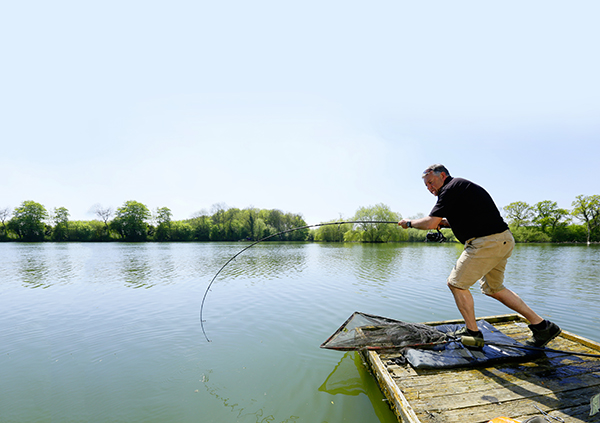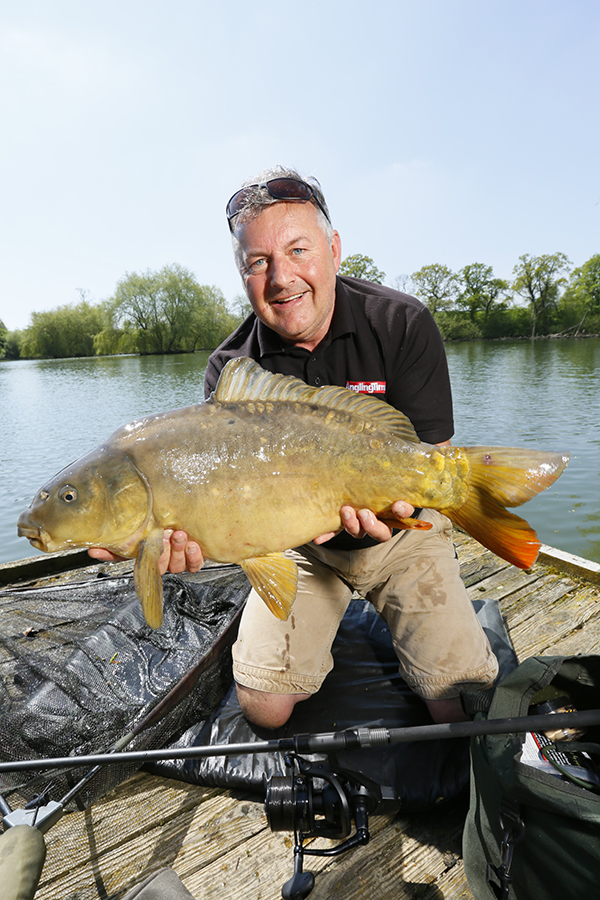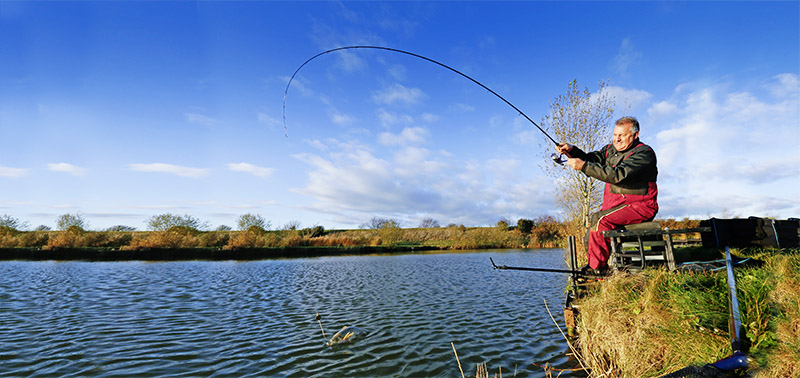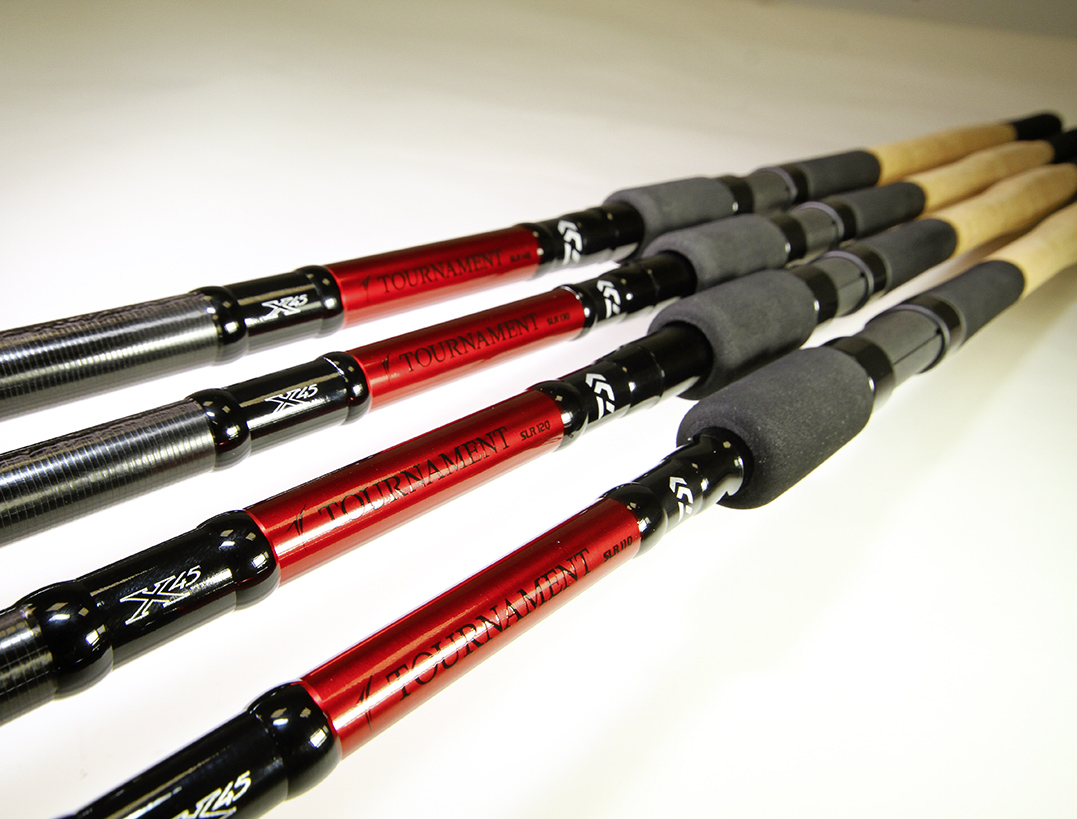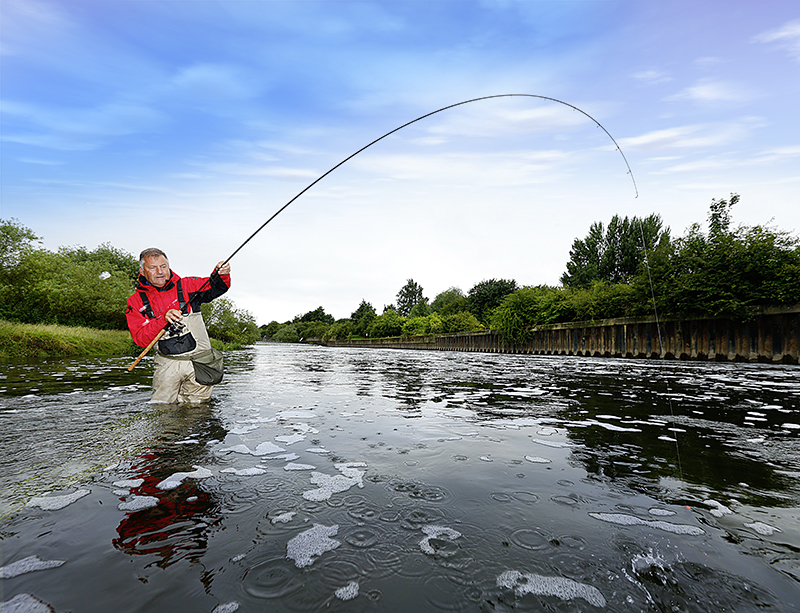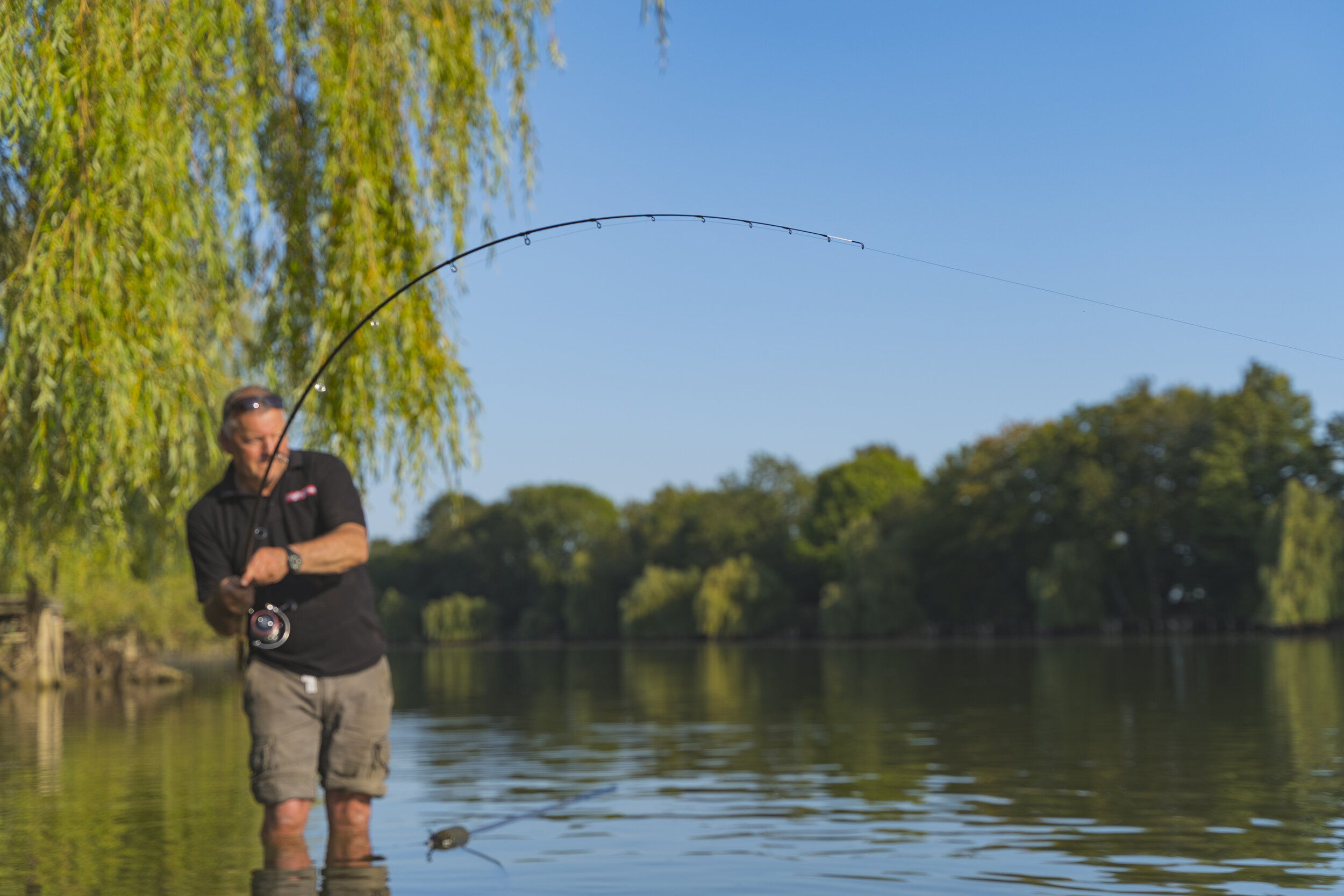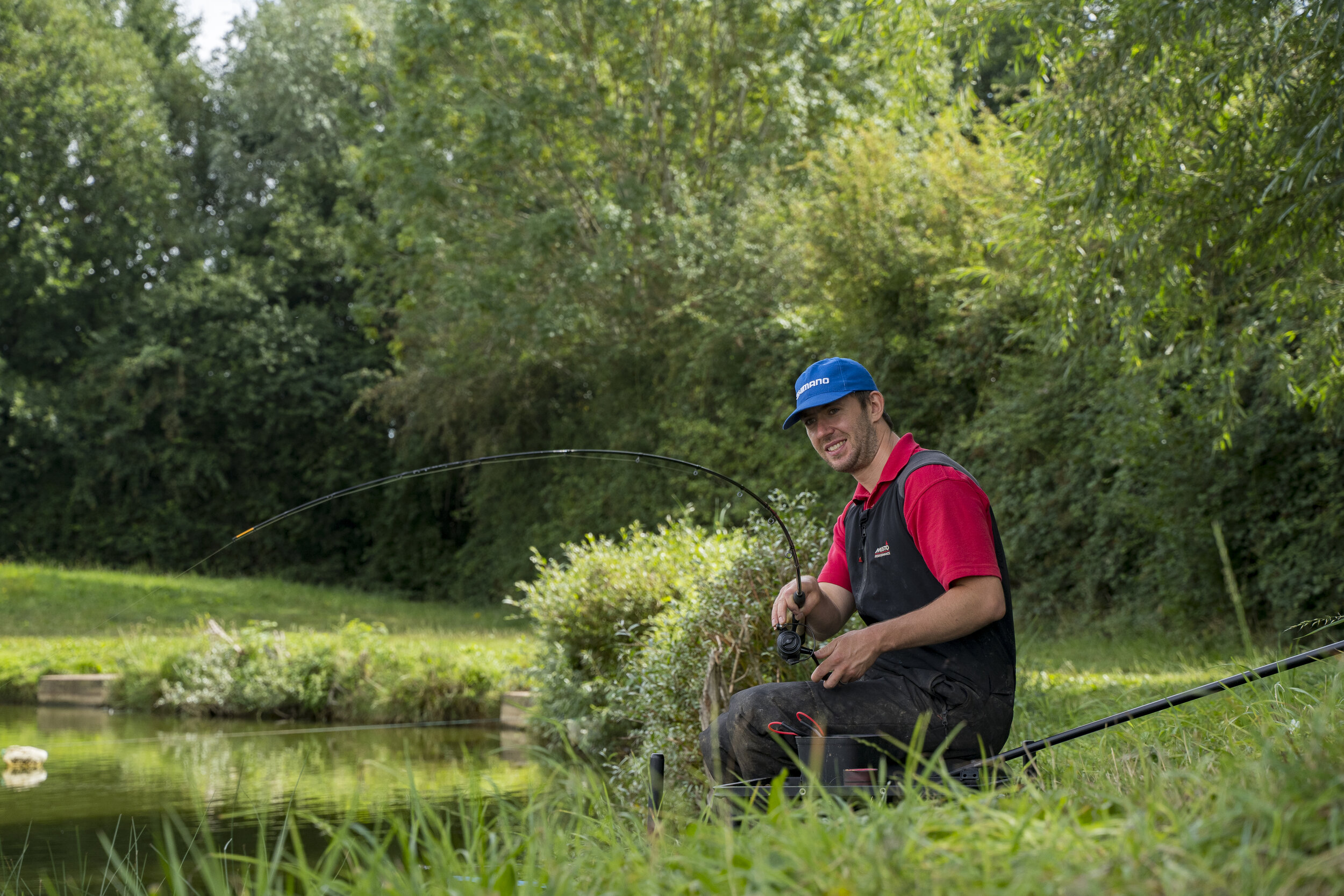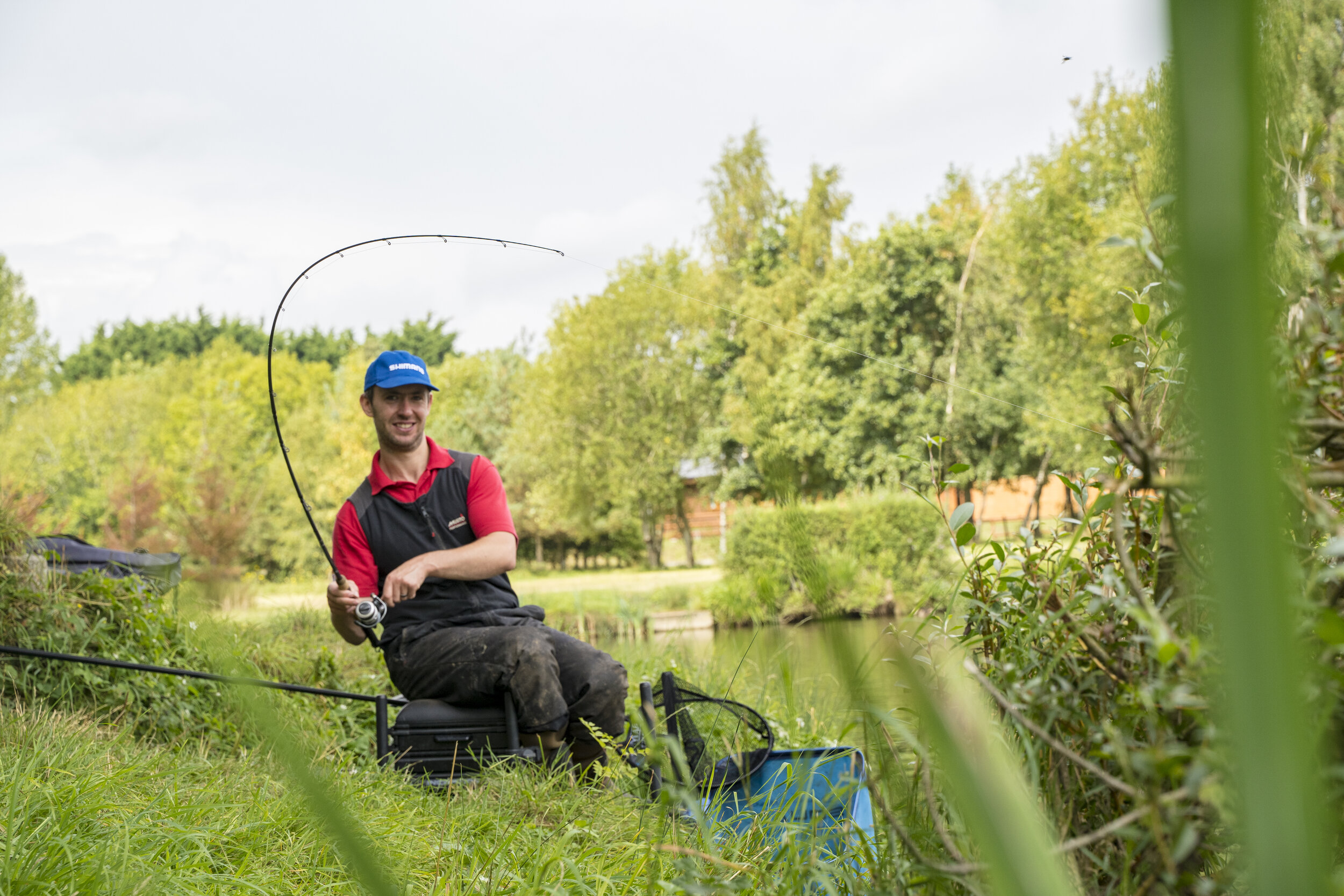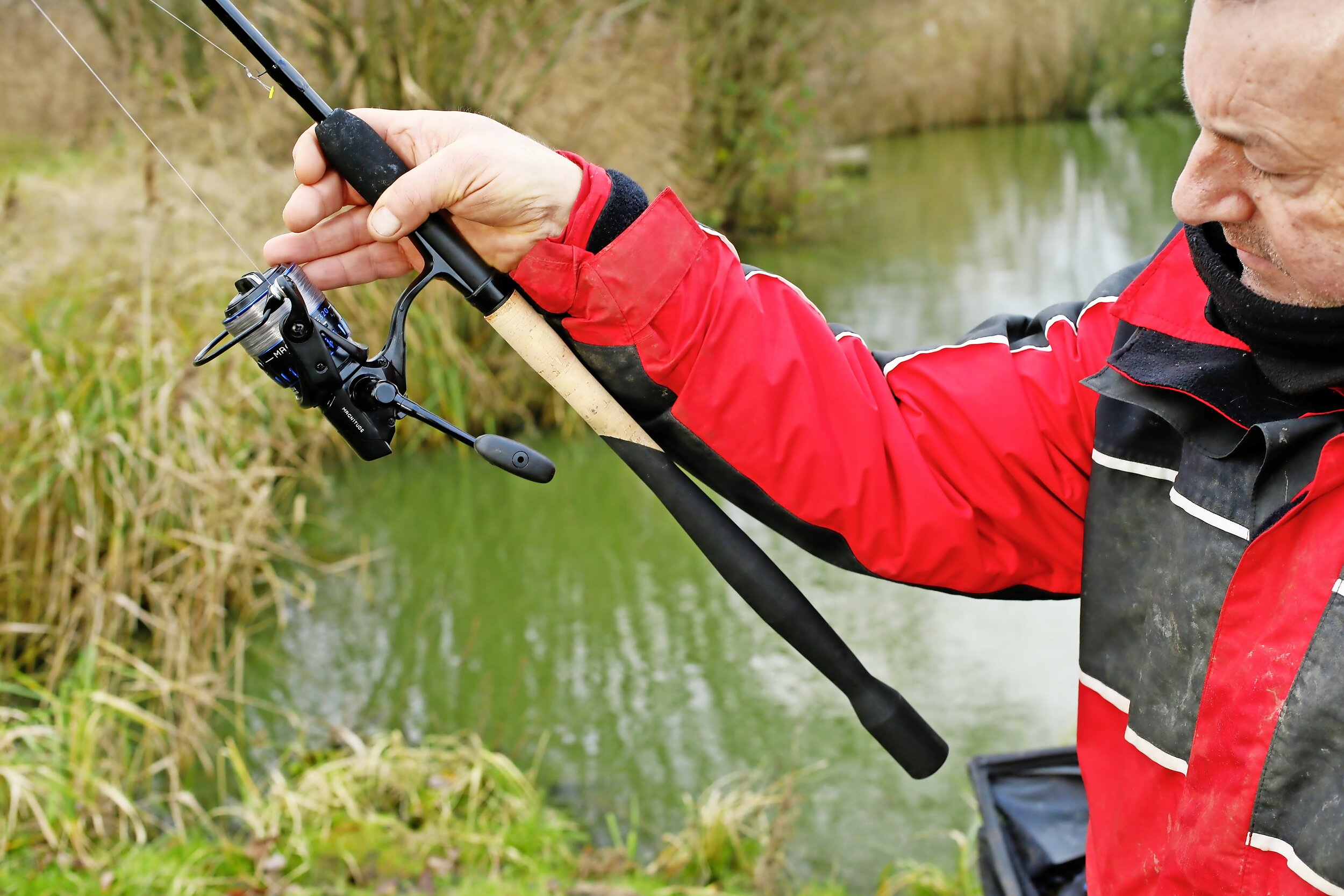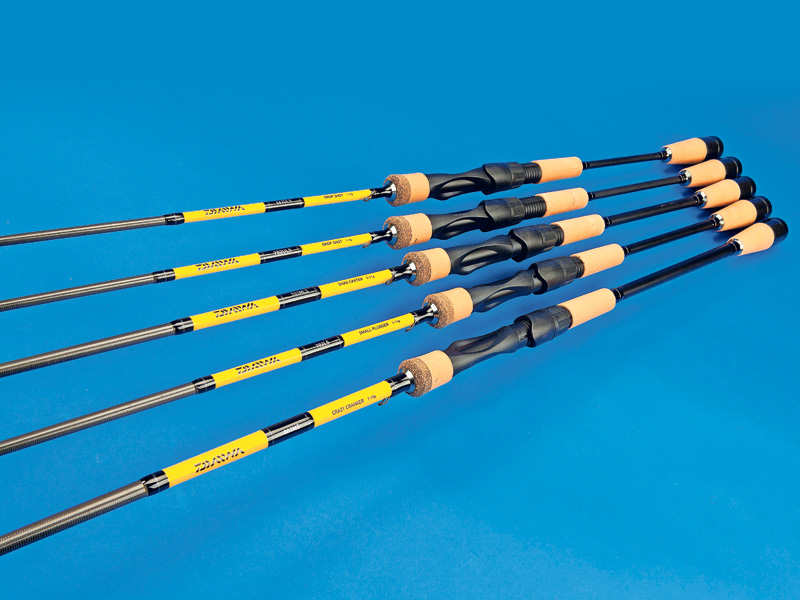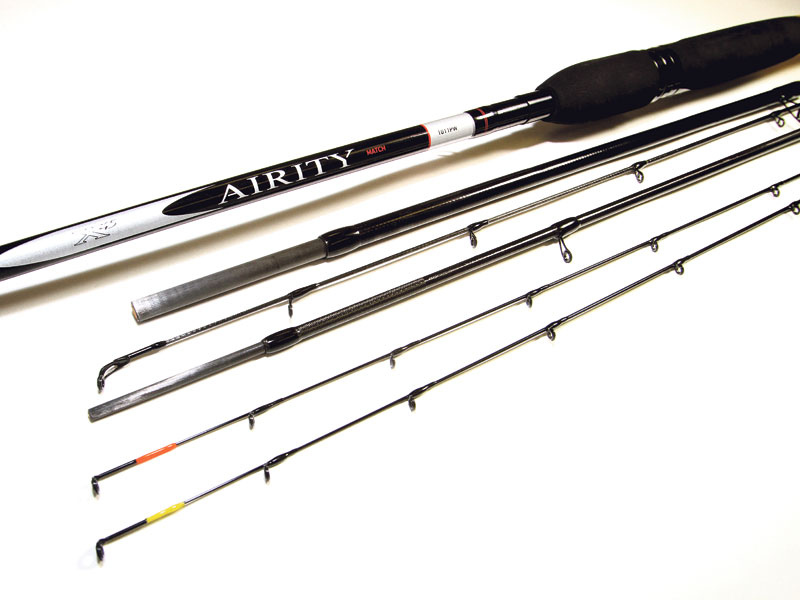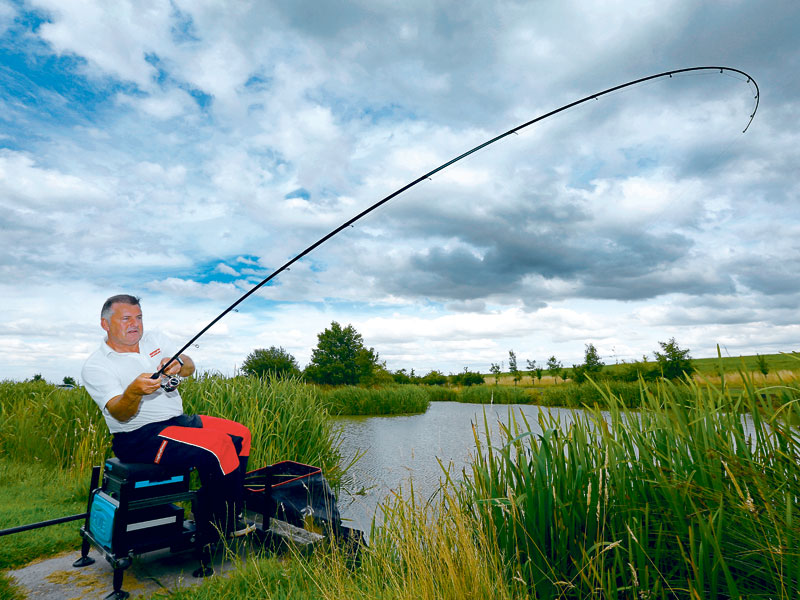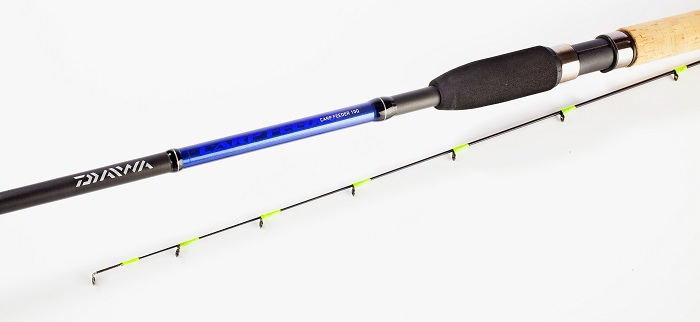Daiwa Powermesh B2 2.25lb test curve rod & Daiwa Emcast 25A reel on test!
THE year was 1974 and I remember it like it was yesterday – Mud’s Tiger Feet had been at No1 for weeks and I’d just met my future wife at school, although I didn’t know it then. Harold Wilson was Prime Minister, and those pesky Germans had won the World Cup for the second time (and two more to come, but I didn’t know that either).
More importantly, my dad had landed a new job with Yorkshire TV, had moved up to Huddersfield and was spending his spare time barbel fishing on the River Swale.
School holidays couldn’t arrive quickly enough. We simply didn’t have barbel nosing around in the Rivers Evenlode or Windrush close to my Oxfordshire home. To this angling-mad lad, catching one became a teenage obsession.
Well, the big moment finally arrived on the banks of the Swale at Skipton. That fish fell to a cube of Bacon Grill (Dad’s favourite). There it lay in the net, seven pounds of statuesque bronze magnificence!
These days, Dad’s living in Italy, chasing carassio and carp, while I live close to the Trent where barbel grow to immense proportions. Ranks of green and camo-clad anglers line its banks looking like soldiers going into battle, as well they might, because the fighting qualities of a natural-born Bertie are more than a match for the stoutest tackle and strongest nerves.
All this brings me to the subject of this week’s Live Test, the latest incarnation of Daiwa’s two-sectioned 12ft Powermesh B2 barbel rod, available in 2.25lb and 2.75lb test curves.
Daiwa had also kindly sent in its new gunmetal grey Emcast 25A reel, which I really liked the look of the moment I saw it.
I don’t know anywhere better to test rough-and-tumble barbel gear than the Trent’s boisterous Gunthorpe Weir. It’s a heaving, boiling, foam-flecked torrent of water whose deafening roar blots out every other sound.
The Trent’s Gunthorpe Weir is the perfect testing ground
An extraordinarily exhilarating angling experience it may be, but boy is it tough on tackle! It’s a boulder strewn snag-pit, and even with Arnie-grade end gear you’re never going to land everything you hook.
I filled the stunning-looking Emcast reel with 15lb Daiwa Sensor line, which you could use to haul a tractor out of a ditch. It was probably a bit overgunned for use with the lighter 2.25lb Powermesh B2 rod that I had chosen to use, mainly because it’s likely to be the one most anglers will prefer.
The Emcast Reel looks simply stunning
I didn’t need to cast anything weightier than a 2oz lead and a PVA bag. The rod has a 150g (5oz) recommended maximum casting weight, but if I were using anything approaching that or casting over 75 yards I would opt for the 2.75lb Powermesh B2.
With a small bag of pellets and meat, and three hair-rigged cubes of porky goodness, it wasn’t long before I had my first bite, and it took even less time for the fish to get itself set firmly into a snag. Fish one, Mark nil.
A simple set-up for barbel
Twenty minutes later the rod top nodded, then the line went slack with a massive drop-back bite. As I wound down to the fish it took off at an astonishing rate of knots, straight across the white water. Happily the Powermesh had enough backbone mid-section to pile on the pressure, despite its fairly soft through action – I’d describe it as forgiving but firm.
Eventually the fish came up in the foam, but the 11lb hooklength had somehow wrapped itself around a loose bit of floating branch. Two attempts to net the whole lot in one go failed dismally, and a desperate third go at scooping up what looked to be a 10-pounder ended in failure. Fish two, Mark nil. Not the rod’s fault, nor the reel’s. Bad angling? You be the judge, but like I said, this isn’t a swim for the faint-hearted.
The Powermesh rod is forgiving but firm
The sun rose, the temperature soared, and I wondered if my chance had gone. Nope, the rod buckled over and it was game on... alas, the line fell slack again just as quickly, and it really was all over. Fish three, Mark nil.
The day wasn’t a complete wash-out, as a decent chub put another bend in the Powermesh, although nothing compared to the brute force of a wild barbel.
This faultless two-piece rod is mellow yet gnarly and growly and would suit nearly all UK rivers. The new Daiwa Emcast reel is just fab – it has an impeccable line lay, and enough winding power to cope with the heaviest of feeders and leads.
A brilliant combination
I really enjoyed its tough and robust feel, which is just as well for a reel likely to get chucked around a riverbank and needing to cope with hauling in double-figure fish. It even comes with a spare spool, so next time I go out with this dream rod-and-reel team I hope to get my three-point win with those barbel.
Price: Rod £126, Emcast reel from £74.99
Daiwa N'zon S Method Feeder rod test
I’M a sociable enough bloke, but like everyone I enjoy my own company now and again. So, what better way to spend some outdoor ‘me time’ than fishing a small river for chub?
When I go match fishing, I typically arrive at my peg loaded down like a pack mule, but today I was travelling light, carrying nothing more than a rigged-up quivertip rod, a landing net and a small shoulder bag holding all my little terminal tackle items.
It was a typical winter’s morning, with a clear blue sky and frosted grass that crunched underfoot as I made my way to test Daiwa’s new 11ft N’zon S Method Feeder rod.
Looking downstream from the footbridge, the River Nene wound its way across the surrounding fields, and even in the half light of dawn, it didn’t take me too long to spot a few areas that looked good for a bite or two.
Watercraft is all about reading the flow, with its creases, ebbs and glides, and learning how to spot fish-holding features. Undercut banks, floating rafts of vegetation, and overhanging trees are all likely to hold a chub or three.
As I trudged along I couldn’t help but remember my old man’s advice. “Stay quiet, stay low, but don’t stay too long, boy,” he would say.
The chub is an enigmatic species. Sometimes its greed overrides caution, and I have on more than one occasion caught the same fish twice in a day. That said, the majority of the time they can be incredibly wary and easily spooked.
All-round performer
When it comes to trying to find the perfect small-river chub rod, I’ve tried the lot over the years – expensive hand-built-models, off-the-peg big-name brands, even cut-down float rods – all the while seeking that perfect action that blends a soft, cushioned tip with a steely but forgiving mid-section that morphs into something with enough poke to halt a snag-seeking chub in its tracks.
I began to think that the perfect small-river chub rod was little more than a wishful thought but then, out of nowhere, like a genie from a lamp, up popped the rod I was using today.
Now, don’t let the name fool you, because it’s a small-river masterpiece. The pencil-slim carbon blank has a lovely through action, with not the merest hint of a flat spot, but despite its dainty demeanour it’s certainly pokey enough to turn the head of any plump chub.
Its weight casting rating is bang-on at around 50g (2oz), which means it will handle most sizes of feeders, but most importantly for me it will handle the small-bodied 20g and 30g wire cage models I use when feeding liquidised bread alongside breadflake hookbaits.
Having walked the river and fed a few areas, I figured that my best chance of a fish or two would definitely come from a spot near the far bank where a back-channel met the main flow, forming an area of flat water on the surface – it absolutely screamed ‘chub!’
Action stations!
It wasn’t the easiest of casts, with little room for error, but the N’zon propelled my cast straight and true, and with a satisfying ‘plop’ the feeder hit the mark. The line tightened against the stream, and the quivertip set into a perfect curve.
Not 10 minutes had passed before a familiar ‘tap, tap’ on the tip indicated there was a fish in residence. The rod whacked round as if the hookbait had been engulfed by a barbel and not the modestly-sized chub that splashed its way into the net 30 seconds later.
It’s safe to say that it wasn’t my biggest chevin, and it was followed by two more of a similar size. No doubt yet another ribbing in the Angling Times office would ensue. But you know what? I didn’t care. I’d had a lovely morning wandering along the river and was more than content with my lot.
As I strode back along the bank towards the car, the rod was so light in my hand that I barely noticed I was carrying it – yet another big plus-point of this magical little wand.
Take it from me, if you want a rod that will handle all you can throw at it on commercial fisheries, and double-up as a superb little river-roving tool for chub and silverfish in winter, this two-piece jewel from the Daiwa stable will put a spring in your step.
Price: £95, www.tackleuk.co.uk
Daiwa N’ZON Z XL 13ft feeder rod Review
A few weeks ago we looked at Daiwa’s latest N’ZON tackle range for feeder anglers.
There are more than 30 new rods in the line-up, three dedicated feeder reels, luggage and nets, not to mention superbly designed ‘tough as you like’ feeders.
Here there’s a choice of metal cage, distance, tunnel and square models and plastic-bodied open-enders, plus three coated bombs – dubbed Tri, Quad and Oval.
So without further ado let’s take a closer look at an N’ZON rod. Those with the ‘Z’ prefix, including the Z XL 13ft Feeder on live test duty, are the more expensive models, ranging from £165 up to £235, while the ‘S’ range starts at £84.99 and rises to £110.
Both marques cover all feeder disciplines, from short bomb work to hitting the horizon.
Daiwa rates the 13ft Z XL Distance Feeder rod to casting weights up to whopping 180g (6oz), and it’s worth mentioning that there are two other 13ft
Z XL rods rated to 120g and 150g respectively, plus three Z series 14ft rods with the same loading capacities.
Not so long ago such rods would have been considered specialist tools, suited only to European anglers. However, these days Irish loughs and Scottish lochs, big wild waters, and huge reservoirs such as Bough Beech and Boddington are commonly used for feeder matches. So there is a need for distance-casting tools that can handle hefty feeders and a wide range of fish species.
Having fished with the rod on three occasions when distance casting was a priority, I can tell you that the N’ZON Z, XL is fully up for a big chuck.
Obviously its 13ft length helps generate added tip speed if you allow a decent drop between rod-tip and feeder prior to the cast. This, matched with a high weight loading point and fast taper three-section blank, adds up to a mega-pokey rod.
I have caught a few skimmers and roach on the Z XL 13-footer, and I didn’t suffer problems with lost fish or hook pulls – although I wouldn’t go below a size 16 hook or line lighter than 0.16mm.
I can see this rod being an option for those who target big-fish venues and need to cast heavy feeders or leads into the middle of next week.
Mark’s verdict
Good as this rod is for distance work, I would probably choose the 150g or 120g Z XL 13ft Distance rods as these would provide a more cushioned, progressive fish-playing action, rather than the raw power of the 180g model.
I can, though, see match and pleasure anglers who fish the Trent, or any major river that needs to be tackled with hefty feeders and end tackle, finding a place for it in their rod holdalls.
Price: £225
Daiwa Black Widow G50 12ft Rod & Reel Review
If you’re just starting carp fishing, or looking for a set of rods and reels that you won’t have to spend years paying off, then you’ve never had it so good.
Improvements in technology and manufacturing have seen the quality of sub-£100 rods rocket beyond all expectations.
Daiwa’s extensive Black Widow range can certainly be classed as excellent value for money.
Covering everything from rods and reels to accessories, each item is well constructed and sensibly priced.
For this test I focused on the Black Widow G50 rod, having picked out the 12ft, 3.25lb test curve rod from the range of six.
There are also 2.75lb, 3lb (both £74.99) and 3.5lb (£79.99) versions available, as well as a 4.5lb rod for spod and marker work which retails at £84.99.
For those fishing on smaller waters, or in tight swims where casting is hampered by overhanging branches, there’s also a shorter 10ft, 3lb model.
My 12ft rod – or set of three, to be precise – were matched with Daiwa’s Black Widow 25A reels.
This is a combo I’ve had a few sessions with, catching several carp to mid-doubles during evening trips of just a couple of hours.
For the purposes of this shoot, I’d arranged to meet our cameraman Lloyd at my local lake in Somersham, Cambs.
Set in a 12-hectare nature reserve, the lake is a few acres in area and home to a real mix of species, including a good head of carp to more than 20lb.
On arrival I could see several fish mooching around in open water and close to large set of lily pads – the perfect target.
I flicked out one rod with a 12mm white wafter hookbait and a small PVA bag of pellets attached to the hook.
I was still sorting out the second rod when my bite alarm emitted a couple of bleeps. Seconds later I looked down just as the bobbin pulled up tight and the spool on the 25A reel started spinning.
Although I was fishing in open water I had to quickly pile on the pressure as the hooked carp was kiting directly towards a dense raft of lily pads and the sanctuary its tangled mass of roots and stems would offer my hoped-for prize.
When you enter 3lb-plus test curve territory there’s often the risk of rods being a bit pokey, and you have to sacrifice fish-playing subtlety for casting capabilities.
I was pleased to discover that this wasn’t the case with the Black Widow G50.
The rod loads across its whole length, which results in a good cushion for hookholds and enables the rod to absorb any sudden lunges under the rod-tip when you’re about to net a fish.
Thankfully, with the rod’s help, I managed to convince the fish that charging into the lily pads wasn’t the best idea and it was soon safely in the bottom of the landing net.
Over the next couple of hours, we landed four more carp to mid-doubles, and at no point did I feel like any of the fish was going to escape.
Every lunge was cushioned by the rod, and the 25A reel’s abbreviated drag range enabled me to quickly adjust the tension on the clutch as required during the fight.
These Black Widow reels fall into the compact category of carp reels, or ‘baby big-pit reels’ as they’re often referred to.
Don’t be fooled by their size – they can still hold 240m of 0.32mm/12lb line and retrieve 92cm of line with each turn of the handle.
The truth is that on most waters in this country, except for the largest of venues where fishing at extreme distances is called for, big-pit reels with huge spools aren’t really necessary.
The 25As will do the job perfectly. And they look great! The all black graphite body is not only strong and keeps weight to a minimum, but sat under the rod’s full Duplon handle they provide a set-up that would please even the most flamboyant of tackle tarts.
Daiwa Black Widow Barbel Rod 12ft 1.75lb & Black Widow Specialist Rod 12ft 1.5lb Review
Looking every inch like expensive custom-built rods, the two 12ft Daiwa Black Widow Barbel and Specialist models are built using full-carbon two-piece blanks that are garnished with an understated matt non-glare finish.
They are furnished with a well-spaced set of durable stainless steel framed guides that have hard-wearing, braid-proof aluminium oxide linings. Both rods also have hollow tubular top sections that are ideal for fishing situations which require the use of heavier leads, feeders, and stronger than normal terminal tackle.
However, before you run away with the idea that this pair of affordable specialist rods are both little more than ringed broom handles, they are both supplied with permanently fixed 2oz test curve glass quiver top sections ideal for targeting shy-biting fish or when tackling still or slow, meandering water where a more sensitive set-up will be beneficial.
Which rather bizarrely is a million miles away from where the pair actually underwent their endurance of a live test. Heavy rain and high water levels just after the start of the new river season had meant that the fish had been pushed out of the normal areas I would expect to bag barbel and catch reports from the opening week were pretty sparse. After a few phone calls I discovered a few fish were being caught from the tidal Trent. If anywhere’s going to test a barbel rod to its limits it’s here, I thought to myself. If it can survive this test it will handle anything else.
The Tidal Trent is a serious water. It’s wildly fast flowing in spots, very deep in places, boils and bubbles like a witch’s cauldron, and is generally completely unforgiving of angling errors.
Its rock and boulder banks and bed are a nightmare, and just to make things doubly difficult for the angler, it flows both ways depending on the tide of the day. Oh yes, it’s quite tasty too but most definitely more Vindaloo than Korma!
The fish that swim the inhospitable depths of the Tidal Trent are nothing less than lean, mean, super fit fighting machines. Think of them as permanently living on a fast-paced treadmill! And that’s what makes the tidal reaches so popular with a multitude of match and specimen anglers. It’s wild water fishing at its raw best.
So where and how does this Daiwa pairing fit into the equation? Well although both rods are close to the cusp on both casting weights and casting distances on a river such as this, the lighter Specialist model is well worth a look, even if you’re a match angler targeting fast-water bream, skimmers and hybrids.

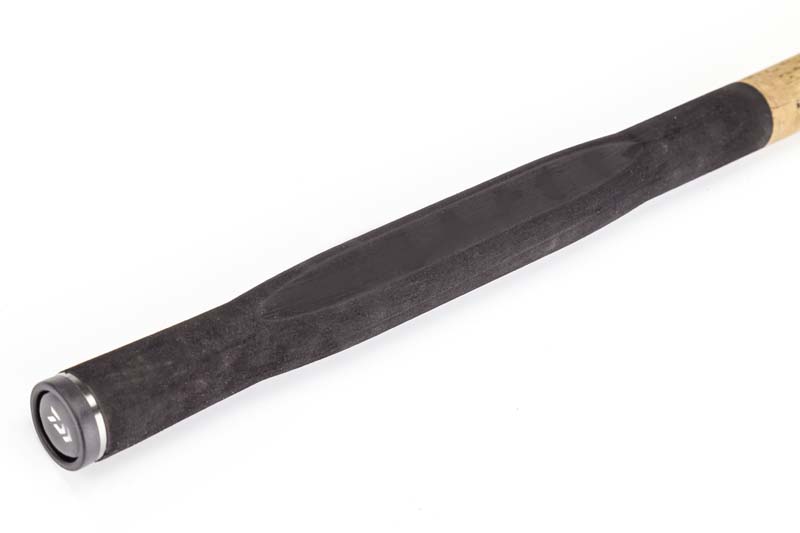

It has a bit more backbone for casting heavier feeders than a normal match style quivertip feeder, but with just enough cushioning softness to allow for lighter lines, from say 0.14mm and more, and smaller hooks from size 16 hooks upwards.
The Barbel model was pushed to its absolute limit on this live test, as the session kicked off with a hefty 70g feeder cast to mid-river and went up from there, as the ebb tide pulled hard. Fish-playing wise, the blank’s progressive action is a little too much for a powerhouse river such as this, and I did lose a couple of big fish I couldn’t keep out of the boulders. Maybe it was it was just bad angling on my part. But let’s face it, none of us ever blame ourselves! And the occasional loss is always going to be expected when fishing such an extreme venue.
By the end of the test, however, the number of fish the rod put on the bank vastly outnumbered those that had escaped. If rods could talk, this one would have said ‘thank flip that’s over with!’
Mark’s verdict
For my money the Black Widow Specialist model would make a good stillwater tench and bream tool and would also double-up as a very handy winter chub rod for any water. The Barbel model is an ideal all-rounder for any river, maybe better suited to the more sedate Thames and Avon flows, where its 2oz fixed quivertip section would come into play. Pacier rivers such as the Wye, Severn and Trent could be tackled with its tubular carbon top section.
The tidal Trent really is at the upper limit at what the rod can handle. But the venue is a different animal to most waterways and normally requires tackling with what can be hugely expensive bespoke rods. The fact that this high value for money Black Widow rod tamed plenty of fish from this river speaks volumes about how good it is.
Daiwa Crosscast Rod & Reel Review
Looking to get into big-carp fishing on a budget but don’t know what rods and reels to buy?
Simple! Read this review, then watch the video on Daiwa’s Crosscast 10ft, 12ft and 13ft rods with test curves from 2.75lb to 3.5lb. Built around Daiwa’s proven 1K woven carbon blanks, these beauties will help you to add yards to your cast.
A responsive, progressive action ensures that you’ll stay in control of the hardest-fighting fish.
Team one of these with the new super carpy Crosscast carp reel packed with top-end tech including a superb QD front drag system, HIP line-friendly clip and super smooth Diggigear retrieve and you’re off to a flying start!
CROSSCAST 5000C QD REEL
Daiwa’s latest Crosscast Carp 5000C QD is, in my opinion, a big pit game changer of a reel.
Packed with more technical wizardry than a Euro jet fighter, not only does it hit the heights in performance terms, but its classic all-black finish and sharp body lines are up there with the very best in the style stakes.
The Crosscast slow oscillation system produces a line-lay that even to the trained eye looks as precise as you would expect to find on the most expensive reels. And as the reel is endowed with Daiwa Digigear it has a ramped-up, silky-smooth winding transmission that pulls in 106cm of line per handle crank.
The front-of-spool QD (quick drag) system works a treat, with nothing more than a few clicks on the spool knob needed to pile on or reduce the pressure when playing a big fish. QD also makes easy work of setting the reel spool up perfectly under any conditions for your next run.
The amount of line (300m of 0.35mm) you can get on to the
long-cast spool will appeal particularly to those who like to place their baits at range using a bait boat.
During the live test I played a big fish while standing waist-deep in water, then purposely dropped the reel into the wet stuff for several minutes while I unhooked the fish.
Did a dunking affect the reel and how it performed in any way? Well... quick shake dry and it was working just as well as when I took it from its box. How on earth does Daiwa produce this reel for under £80?
Price: £79.99
CROSSCAST CARP 12ft, 3lb test curve
Thanks to a dependable carbon weave material and a decent array of furnishings, Daiwa’s Crosscast carp rods are as easy on the eye as they are on the pocket.
For a modest amount of moolah you get ceramic LS-lined guides (including a 50mm butt guide and anti-frap tip ring), full flared shrink-grip handle and an original Fuji reel seat.
The 12ft, 3lb test curve model on live test duty is a ‘Steady Eddie’ of a performer that can turn its hand to just about any method. It will handle solid PVA bags and straight lead set-ups, and is just about soft enough on the top of its tip section for zig tactics using hooks as small as size 12.
Very well suited to smaller or middle-sized venues, it will chuck up to 65 yards with ease, and will achieve 100 yards-plus in the hands of an accomplished caster.
However, the Crosscast is definitely not a horizon-buster, but more of an all-round tool for the newbie carper looking for a dependable and good-looking carp rod on a realistic budget.
Price: £89.99
Daiwa Tournament pro feeder review
In match fishing you can test yourself against the very best, using the same equipment as the stars.
Not so in other sports. Try popping down to your local Mercedes dealer and asking if you can have an F1 car like the one Lewis Hamilton drives. Or see if you can get on the Etihad pitch just because you’re wearing new Adidas footy boots!
Spiky accusations of having ‘all the gear and no idea’ are often levelled at match anglers, but there’s lots to be said for using tackle chosen by world-class anglers. If it’s good enough for them, it’ll be good enough for you!
So when Daiwa launched its Tournament Pro Feeder 10ft and Tournament Pro 9ft-10ft Feeder rods late last year I was itching to get my hands on at least one of the pair. But before revealing my thoughts on the new Tournament Pro Feeder 10ft that landed on my desk, allow me to dispel any false news that you may have heard about Daiwa’s latest Tournament Pro Match and Feeder rod range.
The only changes are improvements to their spec – the handles are sexier than ever, with a new cutaway design and ‘Tournament’ embossed EVA foregrip. That, plus an improved matt black Tournament reel seat and new guides, is the sum total of the changes. Bias V-Joints, HVF Nanoplus materials and Megatop quivers remain exactly the same.
Anyway, on a wickedly cold late January day came my chance to have a closer look at the new Tournament Pro Feeder 10ft. The weather, need I say, was brass monkeys, but Westwood Lakes near Boston are always good for a few bites. I chose Swallow, a narrow snake lake packed with F1s, carp and skimmers, and the ideal venue for a rod like this.
Rob, manager of the on-site tackle and bait shop, advised me to fish peg 4, where you only need to cast a small maggot feeder two foot from the far bank to have them lining up – or so Rob said!
Three hours later, as Angling Times staff photographer Lloyd sat in the car with the heater full on for fear of his long lens freezing and dropping off, the rod tip finally moved.
A fractional twitch of the super-sensitive 0.75oz Megatop quiver was enough to strike at, and the first fish of the day came grudgingly to the net.
The rod, like all Daiwa Tournament Pros, has a blank built in Scotland, delivering flex and action without compromising accuracy or casting power. The pain barrier is in the wallet. The full asking price of £415 works out at around £41.50 per foot… and well worth it.
The blank’s outstanding forgiveness is a wonder to behold, yet it can shift up several more gears if necessary and pile on the pressure without recoiling, twisting or locking up.
As a bonus, this year’s Tournament Feeder rods come with three (as opposed to two) virtually unbreakable Daiwa Megatop carbon quivertips.
On the 10ft rod these are perfectly graded to suit the blank at 0.75oz, 1oz and 1.5oz.
This world-class all-round feeder rod has no equals in its 10ft class. It’s better suited for use on small commercials and natural venues than to long chucks on open water, as it doesn’t have the length to pick up line fast enough, or cast to the horizon. But other than that, the only negative I can find is its price.
Price: £415
Daiwa Powermesh Carp 12ft 3lb test curve review
After around 20 years away, Daiwa’s iconic Powermesh carp rods have returned to the fold.
Seven models span three 12ft rods with 2.75lb, 3lb and 3.5lb test curves. There’s also a distance-casting 13ft, 3.5lb rod, as well as Spod, Floater and Stalker versions, so all bases seem to be covered!
The Powermesh heritage is still spoken of in hushed tones by carp anglers of a certain age, although the new breed are a far cry from their classic namesakes.
These latest rods are slimmer, faster and considerably lighter than the old-school favourites. The one thing they still have in common with the classic Powermesh rods is unbridled power – but more of that later!
Clearly Daiwa, currently designing and constructing its best-ever carp rods across all price points, hasn’t skimped on materials and furnishings for its latest Powermesh offerings.
The slimline blanks boast a strengthened high-grade woven carbon build. When called upon to do so they serve up more than enough casting power for long-distance and PVA bag work.
The astonishing parabolic fish-playing action, as you can see from the image, tightens up quickly across the rod’s mid-section so you’ll stay in charge when faced with hard-fighting big fish in snag pit swims.
As to fittings, these new Powermesh rods are finished to a very high standard, incorporating original Fuji DPS reel seats, slim profile shrink grip handles, stainless steel frame guides with lightweight LS ceramic-lined rings (including a 50mm butt guide) and an aluminium butt cap.
With ‘demanding situations’ a high live test priority, a trip to Oxfordshire’s Clattercote Reservoir was arranged. The big carp on this prolific runs water respond best to long-range solid bag and margin tactics, although the latter option is not for the faint-hearted. Rods need to be picked up and locked up fast to stop fish (as the Drifters sang) going ‘under the boardwalk’.
My choice of rod, the 12ft 3lb test curve Powermesh, can be found online as part of a ‘buy two or three’ package for as little as £84.99.
Now, you may be wondering why, when 3lb-plus tc rods are so popular, I chose the 3lb option. It’s quite simple really, and worthy of note if you’re a prospective customer. Having handled the entire new Powermesh range last October, I felt the 3lb rod was at least the equivalent of a standard 3.25lb or even 3.5lb Daiwa model.
What’s more, having now fished with the rod, I am qualified to say that it’s a fair bit more pokey than its rating would suggest.
That’s almost certainly down to its crisp action rather than its test curve, but bear it in mind if you’re looking to buy a set.
That is a course of action you shouldn’t miss out on if you’re in the market for a set of quality, high-performance carp rods at a sensible price.
They cast brilliantly, will play the biggest of fish superbly well and, I may add, would make awesome French kipper weapons.
Our verdict: The new Powermesh carp rods have enough grunt to safely cast the heaviest of leads, and will outcast virtually all other carp rods in their price bracket.
The fish-playing action is unrelenting, putting you in control at all times – these rods are worthy inheritors of the iconic Powermesh name.
Price: £169, but shop around and look on the internet for multiple deals
Daiwa Yank n Bank 9ft Mini Method Rod Review
Yank n Bank is a brand you might well associate with out-and-out hauling power – the name says it all, really.
Yet the latest rods of this ilk to be released by Daiwa are not all in the bruising doorman class.
There are four Match/Float rods, three of which (10ft, 11ft and 12ft) are Pellet Waggler models. The other is a lightweight three-piece 13ft rod aimed at the silver fish angler.
Six Feeder models include 9ft and 10ft Mini Method rods, and of the two 11ft Method Feeder rods, one is a Power model to tame feisty commercial carp.
They are all light in the hand, with a rapid line-pick-up and a crisp, progressive action.
From comments made to me at a recent trade show, Daiwa is expecting great things from these latest incarnations of its famed Yank n Bank rod range.
Sure enough, all 10 rods are a significant improvement on their predecessors (which were themselves no slouches). Certainly the finish is far better than that on all previous Yank n Bank models.
Live testing a rod, no matter how good it may be, always tends to be a hit-and-miss affair in winter – after all, the fish are shoaled up tightly, and can be somewhat reluctant to have a munch.
However, if you can find them you’re always in with a chance, and it was with knowledge gleaned from recent Decoy winter leagues that I knew a few fish could probably be found out in the middle of the Elm strip lake.
That suited me, as I had wanted to get a much closer look at Daiwa’s latest 9ft Yank n Bank Mini Method Feeder rod since first clapping eyes on one. It struck me at the time that it could be the perfect tool for fishing at 18m-25m, just beyond pole range, and be very well suited to taming the odd bigger fish – Decoy has its fair share of these Gruffaloes.
However, there’s a huge selection of short feeder rods out there now, so what would make this 9ft Yank n Bank offering stand out from the crowd?
For starters, the asking price of just £89.99 is pretty impressive, and you’ll be able to get it even cheaper if you shop around.
Technically it’s extremely well built from high-grade carbon cloth, with a one-tonne carbon weave along its classy gloss black butt section.
This combination not only helps to firm up casting distance and accuracy, but ups the weight it can comfortably handle and provides added steel through the backbone for extra fish-playing control.
The geeky stuff does not end there – the blank’s carrier/tip section boasts a low-glare tape finish. This, although completely at odds with its shiny butt section, imparts a light feel matched with a crisper line pick-up and post-cast tip recovery .
To all that you can add quality furnishings such as stainless steel guide frames with lightweight lined guides, aluminium hooded screw-down reel seat, woven carbon butt frame with rubber cap, ready rod carry case, and a keeper ring as a nice final touch.
On the bank, all this carbon alchemy morphs into a pleasingly lightweight tool which is more than capable of casting 30g with little sign of strain.
Casting performance is further enhanced by its high weight loading point – this enables it to achieve pinpoint casting accuracy, ideal for tricky short distance casts to just past the pole-line.
Obviously it is hugely important to keep your feed pattern tight, and the short 9ft rod is perfect for this, enabling you to keep the bites coming once the fish have been located.
The Yank n Bank’s three graded 1.5oz, 2oz and 3oz push-in carbon quivertips are all well matched to Method feeder use (as it name suggests), although the supplied lightest quivertip is just about soft enough to be used in conjunction with a half-ounce bomb.
Personally I prefer the heaviest, stiffest tip for Method fishing, as that way the fish hook themselves.
The fish-playing action is rapidly progressive, with most of its curvature spread across the top couple of feet, very much in keeping with all modern style short rods.
The seeming lack of playing action should not be taken as a criticism, though, as there’s still enough bend in the rod to absorb the lunges of the heaviest fish, with enough cushioning effect not to drop smaller fish.
However, the purist F1 fanatic may find the rod a tad overgunned for hook sizes above an 18, and hooklengths under 0.12mm.
Price: £89.99
VERDICT
If you're in the market for a quality Method feeder rod for use on smaller lakes, or casting just beyond pole range for decent-sized fish, the new 9ft Daiwa Yank n Bank Mini Method is the ideal tool. Surprisingly steely, it will handle the largest commercial carp while retaining just enough softness to make it usable with lighter set-ups for smaller fish.
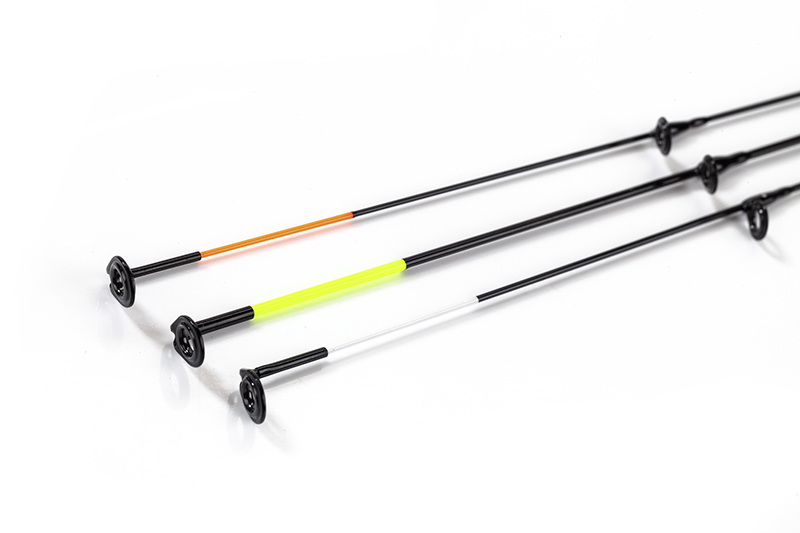


Daiwa Tournament SLR Feeder fishing rod range
The most talked about rod-range of 2018, the Tournament SLRs are already winning fans in the feeder market, most notably Angling Times columnist Steve Ringer.
SLR stands for Super Long Range and these four blanks are the next step up from the original Tournament distance models designed for the European market. With natural style and long range feeder fishing enjoying such a boom again in the UK now too, Daiwa has tapped into this market here, with spectacular results.
Built using Daiwa’s latest X45 carbon technology, these rods feature distinctive red butt section artwork, a boat load of power to cast even the shortest 11ft version a long way, and a fantastic progressive curve for playing fish.
The rods were designed and tested by Steve himself, who described the 12ft version as “the best rod ever”. A 13ft and a 14ft complete the range for extreme distance or big river work.
Other features include Fuji Alconite guides, a Fjui reel seat, dedicated 70cm carbon quivers, Bias Carbon V-Joint, an Armlock handle, a hook keeper and a new 1.5oz quiver on the 11ft model.
Granted they don't come cheap but if you want total perfection than you're going to have to pay for it and the £400-plus price tags reflect this.
PAY AROUND
£405 - £472.50
DAIWA 13ft Powermesh Specialist Float Rod Review
After around a 20-year absence, Daiwa’s iconic Powermesh rods are back with seven new Specialist models for the big-fish angler.
The full collection includes a bespoke two-piece barbel rod; 13ft, 14ft and 15ft float rods; and 11ft 6ins, 12ft 6ins and 13ft 6ins feeder rods with graded 1.5oz, 2oz and 3oz quivertips.
All are constructed from an identical high grade of reinforced carbon, the weave of which gives them that powerful, steely backbone we associate with the Powermesh name.
The rods are furnished to a very high standard, incorporating original Fuji reel seats, full-length cork handles and hard-wearing stainless steel frame guides with lightweight LS ceramic-lined rings.
To that little lot you can add a folding keeper ring, aluminium butt cap and a padded sleeve large enough to house a reel, so rods can be taken to the bank ready made-up.
With ‘demanding situations’ high on my live test objective sheet, a trip to a tackle-devouring stretch of the Trent was in order.
The river here is very shallow and clear, running fast over clean strips of gravel interspersed with waving fronds of streamer weed. You might just catch a glimpse of a pristine golden flank as a big barbel momentarily reveals itself.
As they say, ‘other methods are available’, but nothing beats presenting a bait beneath a float fixed top and bottom. From matching the weight of the float to the river’s flow, to slowing the travel of your bait at just the right moment, or mending the line before running your float through at the same pace as your loosefeed, trotting is an art form. Get it right and at some point your landing net will be graced with a truly stunning wild-born fish.
The rod on test, the 13ft Daiwa Powermesh Specialist Float, allows the use of heavy lines without feeling heavy or cumbersome in the hand, and will cast a waggler or stick float as the situation demands. There’s enough cushioning in the blank to permit the use of sensibly sized hooks and hooklengths.
A rod with all these qualities is a rare beast indeed, and on a day when the river had extra flow after recent rain it cast a hefty 6g alloy-stemmed balsa float without a hitch. At just 6.7oz, the rod caused me hardly any wrist fatigue while I waded the stream.
But it’s when a big fish is hooked that this Powermesh shows its true mettle. It boasts loads of mid-section persuasive power, but the sweet parabolic action cushions sudden lunges when needed, and it transmits plenty of feel through the blank.
In fact, it’s nothing like the broom handles that are often passed off as specialist rods.
Our verdict:
As well as being a river rod, Daiwa’s new 13ft Specialist Powermesh Float is ideal for big tench and bream on the float.
It will cast a big slider or bodied waggler a very long way when needed. It can also be used for big carp in the margins.
The rod is built to stand a bit of abuse, and with all that versatility it’s sure to find its way into the rod holdalls of a host of big-fish specialists.
PAY AROUND
£107.99
Daiwa relaunches its Powermesh Specialist fishing rods
Daiwa has reintroduced its famous Powermesh rods which, back in the day, had a reputation among carp anglers for being cutting edge.
The latest seven-strong collection includes a dedicated 2.75lb test curve barbel rod for float and feeder use. The float rods come in 13ft, 14ft and 15ft lengths and are well suited to heavy waggler and deep-water slider work using reel lines from 3lb-10lb. A crisp action makes them ideal for long-trotting with Avons and big stick floats on fast-flowing rivers for chub and barbel.
The three feeder models (11ft 6ins, 12ft 6ins and 13ft 6ins) all come with quivertips of 1.5oz, 2oz and 3oz test curves, and would seem to be as much at home with open-end feeders for summer tench as they would be tempting winter river chub using maggot and bread feeders.
With casting weights of up to 50g, 70g and 90g, respectively, each rod is built to take lots of stick, reflected in the use of high-grade carbon cloth with a 1k carbon weave along the butt sections for added resilience.
As you’d expect from Daiwa, the classy non-flash matt-black blanks are of the finest quality, with full cork handles, original Fuji DPS reel seats, stainless steel guides with lightweight LS ceramic rings, and hard-wearing aluminium butt caps. All these work together to give the rods a pleasing custom-built aesthetic look.
PAY AROUND
£107.99 to £125.99
Daiwa Harrier Match 13ft rod
PAY AROUND
£54.99
There was a time not so long ago when a three-piece 13ft float rod was standard issue for all match anglers.
Sheffield, Leeds, Rotherham and Birmingham all boasted legions of matchmen whose angling clubs were linked to massive national industries and working men’s clubs. Every weekend would see charabanc outings to the banks of the Witham, Welland, Trent or Severn, where floatfishing was still king and legering came a very poor second.
The best float rods of the day were mainly built on a Golden Jubilee blank, reappearing as WB Clarke’s
All-England, Milbro Enterprise or Billy Lane Match rods.
The first carbon rods weren’t far away, though, and when Fothergill and Harvey’s carbon blank appeared in 1975 they cost a king’s ransom at £133. The early carbon rods, nowhere as good as today’s, cost the equivalent of over £3,000, as much as you’ll pay for a modern flagship pole.
This history lesson earns a place here because 13ft float rods, once the most popular on the market, have evolved tremendously and are available at a steal of a price.
One such model is Daiwa’s 13ft three-piece Harrier Match, which can be found for as little as £44.99.
The rod is built on a decent enough lightweight blank, making it easy and comfy to hold. Its medium-fast action will cast small 3AAA wagglers with no trouble, and it boasts a full cork handle with an EVA lock-down foregrip, lined guides and a matt low-glare finish.
It isn’t the crispest float rod I have ever come across, and it may lack a bit of finesse. But what it can do in spades is handle whatever comes its way – something I was to find out while I was live testing the rod at Boston’s Westwood Lakes.
I had set my stall out for a net of roach and ide, or maybe the odd bream, but the tea-stained Kestrel Lake looked that dirty, I’d have been content to get a bite from anything.
With Storm Imogen racing with unstoppable force across Lincolnshire, this was far from being the best of conditions for floatfishing.
Still, with a 0.10mm hooklength and size 20 red maggot-baited hook on a slow-falling rig, something would surely have a go… wouldn’t it?
It seemed like an age for the bite to come, but eventually it did, and the blaze-coloured float tip sank slowly beneath the surface.
The strike was met by a little more resistance than I had expected, and the rod instantly took on an alarming fighting curve. This action, best described as on the through side of progressive, is pretty much what you want from a float rod if you’re likely to encounter bigger fish.
At first I thought I’d hooked, or even foul-hooked, a carp, hardly what I wanted from a silverfish session, and especially since I was using such lightweight terminal gear.
But as the scrap progressed it became obvious that I had hooked into one of the lake’s legendary barbel.
My balanced tackle was never more welcome than when I slipped the net under a pristine winter Bertram!
The Harrier Match, a long way from being one of Daiwa’s most expensive rods, had absorbed every lunge without my ever breaking sweat that I might get busted up and lose the fish.
Yes, it can be used for small silverfish, but take it from me, the Harrier is capable of an awful lot more when called to battle stations – just like its aircraft namesake, in fact.
VERDICT
On a day when everything but the roach wanted to feed, the Daiwa Harrier proved itself as a great silverfish all-rounder, with enough backbone to cope with much larger quarry when the need arose.
The rod would be well suited to a mixed commercial fishery, where the next bite could come from a matchbox-sized rudd, a powerful carp or, best of all, a belting barbel.
Mark Sawyer
Daiwa Specialist Light Lure Dropshot rods
PAY AROUND
£59.99
Daiwa has added five Light Lure rods to its predator portfolio. The Japanese firm, who can also boast one of the most sought-after light lure rod ranges around in the form of their prestigious Orient-inspired Gekkabijin models, has obviously studied our own lure market carfully before releasing its latest offerings. These rods not only fit the bill perfectly with regard to our drop shot, jig and spin tactics, but they are also sensibly priced at a penny under £60.
The rods offer plenty of scope for the avid lure enthusiast and can be used with light spoons, plugs and shads, as well as the smallest of soft imitations in the case of the two Dropshot models.
These are sure to prove hugely popular, and come in 6ft 6ins or 7ft lengths. Interestingly, they have been designed by Daiwa with identical casting weights from 1g-9g.
If you enjoy working small lures, the Small Plugger rod (3g-14g) should be ideal. The slightly heavier actioned Shad-Caster rod has a 5g-21g rating, while the all-round 8ft Crazy Cranker rod will handle casting weights of between 7g and 28g to cope with larger lures when pike are the main quarry in your sights.
It shouldn’t come as much of a surprise that Daiwa has introduced a small but concise range of rods for our fast-developing lure market.
After all, the global tackle manufacturing giant has acquired and applied more knowledge about developing and constructing short rods for predatory fish than any other company on the planet.
This is a fact that becomes evident within moments of assembling one of the latest Specialist Light Lure Dropshot models.
The ultra-thin two-piece blanks, made frompremium grade carbon, have lightweight single-leg ceramic braid-friendly guides and pleasing cosmetics on a comfy cork split handle.
There’s a tough plastic screw-down hooded reel seat, and a hook-keeper is thrown in for good measure.
However, it isn’t just its stunning build quality that helps this rod to earn a big thumbs-up from me. It also has a very impressive transmission that enables the user to feel every little knock and tremble on the lure, especially, when using a thin braided mainline.
I must also admit that this is the first drop shot rod with a white tip section that I thought was anything more than a needless added extra, and I’ll tell you why. It’s nothing to do with its reflective white colour – something I still don’t see as being necessary.
However, the end of this rod has a seamless flat spot-free 14ins of solid graphite or similar spliced-in tip which has just enough spring, tension and action to help with casting and hook-setting, tempered with exactly the right degree of softness.
This enables you to work a lure with precision and dexterity.
During the live test I was able to tighten up the mainline to a tiny 4g weight without dragging it along the bottom. This, in turn, allowed me to drop the lure on to the bed of the marina while keeping the weight static – a presentation that worked really well for small perch in the cold and dirty water conditions I was faced with.
Like most drop shot rods this one has a progressive fish-playing action, but without the backbone to handle really big critters.
This is not meant as a criticism – let’s face it, 99 per cent of the time it’s perch that fall to drop shot tactics, with anything over 3lb considered a proper specimen.
The rod’s tactile transmission, lightness in the hand and ability to twitch tiny imitations to resemble a tempting snack for a passing stripey are far more important than having enough backbone to bank a big esox. Superb little rods!
VERDICT
These new Daiwa Dropshot rods both come with exactly the same fittings and weight casting ratings of 1g-9g. So the only decision you have to make if you fancy owning one is, which length to go for?
Even then, with only 6ins between them at 6ft 6ins and 7ft, it isn’t really going to affect performance much.
If you do fish water over 6ft deep, though, I would advise the longer model. The action of both is perfect for small lures, giving lots of ‘feel’. They are light and easy to hold for long periods. Pound for pound I would say these are the best bespoke drop shot rods on the market right now.
Daiwa Light Lure rods
Pay around
£59.99
This eye-catching new range of rods is designed for all light lure work and can be used with tiny spoons, plugs and soft lures. Incredibly lightweight, and with plenty of feel and transmission, they will make catching every fish a joy. The two drop shot models feature spliced-in solid carbon tips for added sensitivity.
Daiwa Mission DF Carp rods
PAY AROUND
£125.00
The new Mission DF (Danny Fairbrass signature) models perform well above their price tag. With fittings and furnishings implemented to Danny’s specifications, they feature slime shrink tube handles, 50mm butt guides and a low-glare finish, and are available in 2.75lb, 3lb and 3.5lb test curves.
Daiwa Airity Match and Feeder rods
PAY AROUND
£375-£450
Daiwa has used its tried and trusted Tournament blanks to create this new nine-model Airity series. The extra performance of the latest X45 carbon material is said to offer improved torque and power conversion.
The Airity hybrid 10ft/11ft is every bit as much at home casting a pellet waggler as it is a Method feeder, and will be of great interest to commercial matchman. Look out for an exclusive live test here soon.
Daiwa Harrier Match Pellet Waggler 11ft
TECH SPEC
Full cork handle
Eva down locking fore grip
Matt low glare finish
Light balanced blank
Medium fast actions
PAY AROUND
£49.99
What could possibly prove to be as popular as Daiwa’s TDR and Yank N Bank rods?
Strong contenders must be the 10ft, 11ft (on test) and 12ft Pellet Waggler rods in the new and very affordable Harrier range.
All eight models are realistically priced to put them within reach of anyone wanting to own a Daiwa rod but not blessed with infinitely deep pockets.
That doesn’t mean that the blanks used in their production are in any way inferior, or have cheap fittings. In fact, judging by the test sample sent in to me at Angling Times it’s as though the company has taken extra care to ensure that these bargain-priced models meet Daiwa’s usual high standards.
They all boast a low-glare matt finish which gives them a nice hand-built look, the full cork handles have reliable locking EVA foregrips, and along the blanks are correctly positioned double and then single-leg lined guides which contribute to a medium-fast, progressive action with no flat spots.
Okay, I wouldn’t bet on them being made from the finest high modulus carbon fibre cloths, but these graphite-built beauties feel light and well balanced, with no wobble and a crisp post-cast recovery.
However good a rod may look, the acid test is how well it performs, and a few hours spent throwing around a variety of pellet waggler and splasher floats confirmed the 11ft Harrier Pellet Waggler’s suitability as a cracking small to medium-sized commercial fishery tool.
It is more than comfortable handling floats from 4g up to 10g and reel lines from 6lb-8lb but it’s – let’s say – just a little too ‘manly’ for anything much lighter in the float department.
The fast tapering two-piece blank generates a surprising amount of power, certainly considerably more than I had seen up until now from a graphite-built rod. It’s not overly pokey, it doesn’t feel in the least like a broom handle, but it’s quite a muscular caster. Don’t be afraid to give it a fair old overhead whack to punch out a float against a headwind.
Fish are dealt with quickly and efficiently too, something I found particularly useful when needing to guide lively 3lb-5lb carp around the tackle-wrecking thick reed beds surrounding Sallow Lake on the day-ticket Homeclose Fishery in Rutland.
If you regularly visit a snaggy venue holding big carp that respond well to float tactics, this could be just the rod you’ve been looking for.
It’s built to take the odd knock and bounce back unscathed, and at a penny under 50 quid it really is a steal.
VERDICT
Daiwa has dressed this rod to look like one costing three times the price. Well suited to bigger commercial fisheries, the blank delivers ample fish-playing power and casting clout, but its carefully crafted carbon and glass construction and fast tapering design prevents it from being overly aggressive.
Mark Sawyer
Daiwa Carp 10ft Feeder Rod
PAY AROUND
£34.99
Don’t let the wallet-friendly price tag fool you into thinking that the 10ft Carp Feeder is in any way a budget rod in terms of performance.
Indeed many of the design influences have filtered down from Daiwa’s flagship match fishing rods.
The two-piece blank has been designed to fish lines between 2lb and 8lb so it is capable of handling everything from roach to big commercial fishery carp.
Pick one up and the first thing you are likely to notice is how light the rod is – a mere 7.1oz to be precise.
The quivertips are unique in that unlike pretty much every other tip on the market they don’t feature a solid inch block painted on the end.
Instead they have small high-viz paint rings running down the quiver. These definitely seem to amplify cagey bites, making it the ideal choice for winter F1 work.
Daiwa Exceler 7ft Spinning Rod
PAY AROUND
£49.99
This high quality yet affordable rod from Daiwa is absolutely spot-on for drop shotting. This type of short spinning rod is well suited to smaller venues, which is why on a very cold and windy winter’s day, it accompanied me to several predator hotspots along the tiny Oxford Canal.
But exactly what should you be looking for in a decent drop shot rod? As you’re going to be holding it for long periods of time it definitely needs to be lightweight and this whispish little beauty certainly is that, weighing a mere 4.3oz. It is also essential that the blank has just the right amount of stiffness in its tip to work the lure properly. If it’s too soft, it will simply pull-round cushioning the lure’s movements against the casting weight. If it’s too stiff you not only lose the rod’s sense of feel and transmission, it is likely to be too gutsy for the size of fish you’re likely to be catching, and will pull out the hook.
What you’re looking for is a compromise between these two characteristics and this pencil thin, two-piece, high modulus carbon blank designed for casting light weights between 2g and 10g delivers them delightfully well. It can impart lots of movement with a simple flick of the wrist, and has more sensitivity than a rom-com chick flick.
It also has some very impressive and tasteful furnishings, including a proper cork handle with a wooden butt cap, an original Fuji reel seat and superb braid-compatible titanium oxide lined guides.

